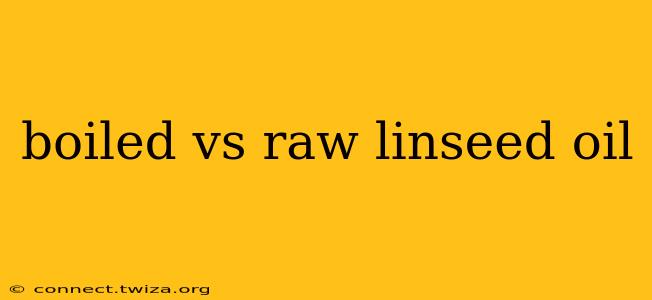Linseed oil, derived from flax seeds, is a popular choice for various applications, from wood finishing to paint making. However, the terms "boiled" and "raw" can be confusing. This comprehensive guide will clarify the differences between boiled and raw linseed oil, helping you choose the right one for your needs.
What is Linseed Oil?
Before diving into the differences, let's understand the base product. Linseed oil is a drying oil, meaning it hardens when exposed to air. This process, called polymerization, occurs due to a chemical reaction with oxygen. The oil's fatty acid composition is key to this process, resulting in a durable, protective finish.
What is the Difference Between Boiled and Raw Linseed Oil?
The primary difference lies in the processing. "Boiled" linseed oil isn't actually boiled in the traditional sense. Instead, it's treated with metallic driers (usually cobalt, manganese, or lead) to accelerate the drying time. Raw linseed oil, on the other hand, contains no added driers and dries much more slowly.
Boiled Linseed Oil:
- Drying Time: Dries significantly faster than raw linseed oil (typically within 24 hours, depending on conditions).
- Uses: Ideal for projects where a quick drying time is crucial, like outdoor wood projects requiring a faster protective layer. It's often preferred for painting and varnishes where a quicker curing time is essential.
- Appearance: Can sometimes appear slightly darker than raw linseed oil.
- Considerations: The added driers can slightly alter the final finish's color. While modern driers are generally safe, some historical formulations contained lead, which is toxic. Always check the product label for safety information.
Raw Linseed Oil:
- Drying Time: Dries much slower than boiled linseed oil (can take several days to weeks to fully cure).
- Uses: Best suited for applications where penetration into the wood is more important than fast drying. Often used as a wood conditioner or for deep-penetrating treatments on porous surfaces. The longer drying time allows for deeper absorption, leading to enhanced protection.
- Appearance: Generally has a lighter color and a more natural finish than boiled linseed oil.
- Considerations: Requires more patience due to its longer drying time. The slower drying may also require multiple applications.
What are the Advantages and Disadvantages of Each?
Here's a table summarizing the key advantages and disadvantages:
| Feature | Boiled Linseed Oil | Raw Linseed Oil |
|---|---|---|
| Drying Time | Fast (24 hours or less) | Slow (several days to weeks) |
| Penetration | Less | Greater |
| Durability | Good | Excellent (after complete curing) |
| Finish | Slightly darker, less natural | Lighter, more natural |
| Cost | Generally slightly more expensive | Generally slightly less expensive |
| Ideal Projects | Outdoor projects, painting, varnishes | Wood conditioning, deep penetration |
Is Boiled Linseed Oil Toxic?
Modern formulations of boiled linseed oil generally do not pose significant health risks when used as directed. However, always ensure adequate ventilation while working with any oil-based product, and wear appropriate personal protective equipment (PPE), such as gloves and eye protection. Historically, boiled linseed oil contained lead driers, but this is less common in modern products. Always read the product label to ensure safety.
Which Type of Linseed Oil is Best for Wood Finishing?
The choice between boiled and raw linseed oil for wood finishing depends largely on your priorities. For outdoor projects or where a quick turnaround is important, boiled linseed oil might be the better choice. If deep penetration and a more natural, durable finish are paramount, raw linseed oil is generally preferred, despite the longer drying time. Often, a combination of both may be used—raw oil for deep conditioning, followed by boiled oil for a faster-drying topcoat.
How Long Does Linseed Oil Take to Dry?
This varies greatly depending on the type of oil, temperature, humidity, and thickness of application. Boiled linseed oil typically dries within 24 hours, while raw linseed oil can take several days or even weeks to fully cure.
What is the Difference Between Linseed Oil and Tung Oil?
Tung oil is another type of drying oil extracted from the tung tree. While both offer protective coatings for wood, tung oil dries faster and is generally considered more water-resistant than linseed oil. They also produce different finishes; tung oil typically yields a harder, glossier finish.
By understanding the nuances of boiled and raw linseed oil, you can confidently select the best option for your specific project, ensuring a successful and lasting finish. Remember to always prioritize safety and read product labels carefully before starting any project.
